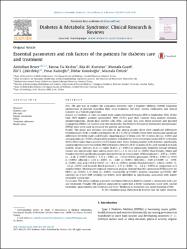| dc.contributor.author | Bener, Abdulbari | |
| dc.contributor.author | Keskin, Fatma Ela | |
| dc.contributor.author | Kurtuluş, Eda Merve | |
| dc.contributor.author | Güzel, Mustafa | |
| dc.contributor.author | Çekirdekçi, Elif İjlal | |
| dc.contributor.author | Kadıoğlu, Pınar | |
| dc.contributor.author | Konukoğlu, Dildar | |
| dc.contributor.author | Öztürk, Mustafa | |
| dc.date.accessioned | 10.07.201910:49:13 | |
| dc.date.accessioned | 2019-07-10T19:51:50Z | |
| dc.date.available | 10.07.201910:49:13 | |
| dc.date.available | 2019-07-10T19:51:50Z | |
| dc.date.issued | 2017 | en_US |
| dc.identifier.citation | Bener, A., Keskin, F. E., Kurtuluş, E. M., Güzel, M., Çekirdekçi, E. İ., Kadıoğlu, P. ... Öztürk, M. (2017). Essential parameters and risk factors of the patients for diabetes care and treatment. Diabetes & Metabolic Syndrome-Clinical Research & Reviews, 11(Supplement: 1), S315-S320. https://dx.doi.org/10.1016/j.dsx.2017.03.008 | en_US |
| dc.identifier.issn | 1871-4021 | |
| dc.identifier.issn | 1878-0334 | |
| dc.identifier.uri | https://dx.doi.org/10.1016/j.dsx.2017.03.008 | |
| dc.identifier.uri | https://hdl.handle.net/20.500.12511/2292 | |
| dc.description | WOS: 000419836500052 | en_US |
| dc.description | PubMed ID: 28285988 | en_US |
| dc.description.abstract | Aim: The aim was to explore the association between Type 2 Diabetes Mellitus [T2DM] treatment satisfactions of patients regarding their socio-economic, life-style, history medication and clinical outcome in a Turkish population Subject and methods: A cross-sectional study conducted from February 2016 to September 2016. Of the total 1500 diabetic patients approached, 1094 (72.9%) gave their consent. Data analysis included, sociodemographic, serum lipid profiles (LDL, HDL), calcium, uric acid, blood pressure and glycated hemoglobin (HbA1c) at baseline and after six months. The Diabetes Treatment Satisfaction Questionnaire (DTSQ) tools were used to measure the patient satisfaction. Results: The mean and standard deviation of age among gender, there were significant differences between males (51.81 +/- 14.40) and females (49.76 +/- 13.99) (p = 0.024). There were statistically significant differences between males and females regarding place of living (city 76% vs town 26%) p < 0.001) and consanguinity (p = 0.040). Almost of the patients with diabetes were overweight (males 44.5% vs females 41.8%) while more than a quarter (31.2%) males were obese. Among patients with diabetes, significantly larger proportion were treated for DM with insulin (females 28.8% vs males 22.5%) and 'insulin & oral anti diabetic drugs' (females 21.6% vs males 18.4%%; p < 0.001) in comparison. Reported average sleeping haours was significantly more among males (6.5 +/- 1.1 vs. 6.1 +/- 1.2; p < 0.001) than females. Males and females reported significantly greater improvements in mean values of blood glucose (-2.07 p < 0.001; vs.-2.36; p = 0.007), HbA1c (-1.72 p < 0.001; vs.-1.47 p = 0.038), potassium (+0.98 p < 0.001; vs. +0.93 p< 0.005); albumin (-3.38 p < 0.001; vs.-3.60; p < 0.001); billirubin (-0.69 p = 0.049; vs.-0.98; p < 0.001); uric acid (+11.9 p = 0.017; vs. +14.3; p < 0.001); systolic blood pressure (-3.86 p < 0.001; vs.-3.2 p < 0.001) and diastolic blood pressure (-3.17 p < 0.001; vs.-3.2 p < 0.001) in comparison to 6 months before. Multivariate stepwise regression analysis showed that the satisfaction DTSQ scores for HbAlc (p < 0.001), h of sleep (p < 0.001), neuropathy (p = 0.007), diabetic education (p = 0.014), SBP (mmHg) (p = 0.021) DBP (mmHg) (p = 0.028) were identified as significantly associated with higher treatment satisfaction. Conclusion: The study confirms a positive correlation between diabetes patient's satisfaction with care and treatment. Females DM patients compared to males had a better satisfaction score with current treatment, unacceptably low blood glucose level, flexibility in treatment and understanding of DM. | en_US |
| dc.description.sponsorship | Cerrahpasa Faculty of Medicine and Medipol International School of Medicine, Istanbul Medipol University | en_US |
| dc.description.sponsorship | We are grateful to the developer of the DTSQ Professor Clare Bradley for granting us permission to use the instrument in our study. The authors would like to thank the Cerrahpasa Faculty of Medicine and Medipol International School of Medicine, Istanbul Medipol University for their support and ethical approval. | en_US |
| dc.language.iso | eng | en_US |
| dc.publisher | Elsevier Ltd | en_US |
| dc.rights | info:eu-repo/semantics/embargoedAccess | en_US |
| dc.subject | Diabetes Care | en_US |
| dc.subject | Life-Style | en_US |
| dc.subject | Patient Satisfaction | en_US |
| dc.subject | DTSQ | en_US |
| dc.subject | Treatment Adherence | en_US |
| dc.subject | Health Status | en_US |
| dc.title | Essential parameters and risk factors of the patients for diabetes care and treatment | en_US |
| dc.type | article | en_US |
| dc.relation.ispartof | Diabetes & Metabolic Syndrome-Clinical Research & Reviews | en_US |
| dc.department | İstanbul Medipol Üniversitesi, Uluslararası Tıp Fakültesi, Dahili Tıp Bilimleri Bölümü, Tıbbi Farmakoloji Ana Bilim Dalı | en_US |
| dc.authorid | 0000-0002-1423-0435 | en_US |
| dc.authorid | 0000-0002-7902-5803 | en_US |
| dc.identifier.volume | 11 | en_US |
| dc.identifier.issue | Supplement: 1 | en_US |
| dc.identifier.startpage | S315 | en_US |
| dc.identifier.endpage | S320 | en_US |
| dc.relation.publicationcategory | Makale - Uluslararası Hakemli Dergi - Kurum Öğretim Elemanı | en_US |
| dc.identifier.doi | 10.1016/j.dsx.2017.03.008 | en_US |
| dc.identifier.scopusquality | Q2 | en_US |


















